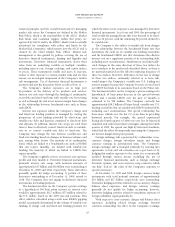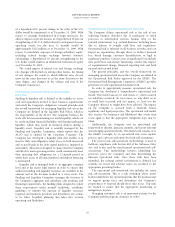American Express 2009 Annual Report Download - page 54
Download and view the complete annual report
Please find page 54 of the 2009 American Express annual report below. You can navigate through the pages in the report by either clicking on the pages listed below, or by using the keyword search tool below to find specific information within the annual report.2009 FINANCIAL REVIEW
AMERICAN EXPRESS COMPANY
RESULTS OF OPERATIONS FOR THE THREE YEARS
ENDED DECEMBER 31, 2009 – GAAP BASIS
The following discussion of USCS segment results of
operations is presented on a GAAP basis.
USCS reported segment income of $249 million for 2009,
a $603 million or 71 percent decrease from $852 million in
2008, which decreased $971million or 53 percent from 2007.
Total Revenues Net of Interest Expense
In 2009, USCS total revenues net of interest expense
decreased $2.1 billion or 15 percent to $11.9 billion due to
lower securitization income, net, decreased interest income
and lower discount revenue, net card fees and other, partially
offset by lower interest expense. Discount revenue, net card
fees and other of $9.1 billion in 2009 decreased $1.2 billion or
12 percent from 2008, due to lower billed business volumes,
reduced other commissions and fees, decreased net card fees,
lower other revenues and reduced travel commissions and
fees. The decrease in billed business reflected a 10 percent
decrease in basic cards-in-force and a 5 percent decline in
average basic cardmember spending. In 2009 within USCS,
small business and consumer billed business volumes declined
13 percent and 10 percent, respectively. Interest income of
$3.2 billion in 2009 was $1.5 billion or 32 percent lower than
in 2008, primarily due to lower portfolio yields and a decrease
in average owned lending balances. Interest expense of $855
million in 2009 decreased $1.3 billion or 61 percent as
compared to a year ago, primarily due to lower market
interest rate-driven cost of funds and reduced average owned
cardmember loans and receivable balances. Total revenues net
of interest expense of $14.0 billion in 2008 were $225 million
or 2 percent lower than 2007 as a result of lower securitization
income, net, decreased other commissions and fees and lower
interest income, partially offset by slightly higher discount
revenue, net card fees and other, as well as lower interest
expense.
Provisions for Losses
Provisions for losses decreased $620 million or 14 percent to
$3.8 billion for 2009 compared to 2008, due to lower loan
balances and improving credit indicators during the second
half of 2009. The lending net write-off rate increased in the
first half of the year and then began to improve in the third
and fourth quarter. Past due rates rose early in the year but
then showed improvement through the remainder of the year
commencing in the second quarter. The write-off and past
due rates reflect in part targeted efforts to manage credit
performance such as reducing high loan balances, as well as
the impact of customer assistance programs, including the
re-aging of cardmember accounts meeting certain criteria.
Provisions for losses increased $1.4 billion or 46 percent to
$4.4 billion for 2008 compared to 2007 due to higher write-off
and delinquency rates in the lending and charge portfolios
reflecting the challenging U.S. credit environment.
Expenses
During 2009, USCS’ expenses decreased $669 million or 8
percent to $7.8 billion, due to lower marketing, promotion,
rewards and cardmember services expenses and lower salaries
and employee benefits and total operating expenses. Expenses
in 2009, 2008, and 2007, included $12 million, $30 million,
and $13 million, respectively, of charges related to
reengineering activities primarily related to the Company’s
reengineering initiatives in 2009 and 2008 as previously
discussed and reengineering activities within consumer and
small business services in 2007. Expenses in 2008 of $8.5
billion were $27 million or less than 1 percent lower than in
2007, due to lower marketing, promotion, rewards and
cardmember services expenses, partially offset by greater
salaries and employee benefits and other operating expenses,
net.
Marketing, promotion, rewards and cardmember services
expenses decreased $571 million or 12 percent in 2009 to $4.3
billion, due to lower rewards costs, reduced marketing and
promotion expenses and the Delta-related charge to the
Membership Reward balance sheet reserve in the fourth
quarter of 2008. Marketing, promotion, rewards and
cardmember services expenses decreased $303 million or 6
percent in 2008 to $4.8 billion, due to the Membership
Rewards related charge in 2007 noted above, the incremental
business-building expenses in 2007 compared to lower
marketing and promotion expenses in 2008, partially offset by
the Delta-related charge in 2008 to increase the Membership
Rewards liability and higher volume-related rewards costs.
Salaries and employee benefits and other operating expenses
of $3.5 billion in 2009 decreased $98 million or 3 percent
from 2008, reflecting the benefits from reengineering
activities, lower net charges associated with these
reengineering programs, the favorable impact in 2008 related
to fair value hedge ineffectiveness and the costs related to the
Delta contract extension in the fourth quarter of 2008.
Salaries and employee benefits and other operating expenses
of $3.6 billion in 2008 increased $276 million or 8 percent
from 2007. The increase was due to higher software,
operations, technology and credit and collection costs, the
pension-related gain in 2007 and costs related to the
Company’s reengineering initiatives in 2008.
Income Taxes
The effective tax rate was 23 percent for 2009 compared to 25
percent and 33 percent for 2008 and 2007, respectively. The
rates for each of these years reflect tax benefits related to the
resolution of certain prior years’ tax items.
DIFFERENCES BETWEEN GAAP AND MANAGED BASIS
PRESENTATION
Due to changes in GAAP governing the accounting for
transfers of financial assets effective January 1, 2010 that will
result in the consolidation of the Lending Trust, the
presentation of financial and statistical information on a
52
























